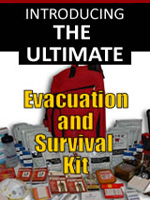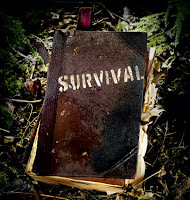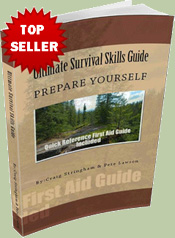George Ure and Gaye Levy, Contributors
Activist Post
Part of living a strategic life is being able to take care of yourself, and a few others around you, no matter what (within reason) the Universe drops on your head. While talk about global bankruptcy is dramatic sounding, a cooler assessment of the odds suggests that through most of human history, a few personal necessities can and do make the difference between life and death.
Here at Strategic Living we will get into emergency food stores, the importance of having stored water, and the need for a good first aid kit (and serious medical training on how to use it) at some other time. For today, let’s talk about something increasingly overlooked in our “modern” society: Fire.
Yes, that cozy friend in the hearth on cool fall evening, that enduring companion while reading and having a toddy with a good book on a wintery afternoon, that smoldering pile of leaves in Fall, the smoke from the BBQ in summertime. Fire is a big deal and a necessary component not only to our senses, but to survival itself.
 |
| Ad |
That said, most people have terrible fire skills. It is not that fire skills are difficult to learn, mind you, it’s just that in today’s world of electronic cooking gadgets, pre-packaged meals, and grab and go dining, using a fire to do something basic like cook seems like a lot of work and a plain nuisance compared to get getting the job done with electricity, natural gas or, ah, those plastic cards we carry around in our wallet.
So today we get down to the basics, namely the basics of starting a fire with the express purpose of cooking in a survival situation.
Rule number 1: There are three parts to fire: Oxygen, Fuel, and Heat. This is referred to as the Triangle of Fire. For the visually oriented, it looks like this:
Building a fire is something to be taken quite seriously. For example, never build your fire indoors, except in a real fireplace. Every Winter, dozens of people die of carbon monoxide poisoning due to indoor heating with charcoal briquettes. When that happens, the victims simply go to sleep and never wake up. Our point being that outdoors confined to a fireproof area or in a real fire place is where fire belongs, period.
That said, the first step and some would say the most important step to having a good fire is getting it started. Amazon carries a variety of fire-starting tools ranging from waterproof matches to a high-end Delta Stormproof Lighter ($41) but we sure like the reliability of a simple Swedish Firesteel – Army Model about $15.
But the oldest (and still a reliable way) to start a fire is to make some charcloth and have it ready to go in your survival kit. Charcloth you say? What the heck is that? Well to be honest, most city-dwellers have no clue what it is, how to make it, and even less how to use it. (Sidebar: and until two weeks ago, neither did Gaye.)
But no worries. Here is everything you need to know about charcloth.
1. You begin by finding a pair of old jeans that you’ve ripped and patched for the last time. You’ll cut patches of the fabric just the right size to lay flat inside an empty Altoid can.
2. Once you’ve about filled the can up, you make a small nail hole on both the top and the bottom of the tin.
3. The next time you have your BBQ fired up you toss in the denim filled Altoid can and let it cook for 20 minutes or so.
4. Remove the tin filled with denim from the grill and let cool overnight. Also, don’t forget to wash the grill off thoroughly when you are done, since remnants of the burning paint from the Altoids can will make an unsavory seasoning to the next piece of food thrown on the grill to cook.
Now if you are a real outdoor aficionado, you can toss the tin containing denim into a real fire (in the ground or in your fire pit) rather than your BBQ grill. By the time the fire has cooled off to nothing the next day, the can will be cold and there no grill to clean. Easy sneezy.
5. To start a fire using charcloth, you simply take ½ a piece of the cloth and tear at it a little bit. Strike your flint so that the sparks land on the tufts of thread which are charred and catch fire extremely easy under a wide range of conditions. All it takes is for the charcloth to begin smoking a bit.
6. The next step is to take some very fine shavings of wood (picture shaving a match-stick to get some small shavings) and toss them on to the charcloth, and blow the charcloth so as to push the burning part into the wood. After a few tries, you should be able to get a fire going easily this way. You can substitute other materials as well: a square or two of (yes, of course unused) toilet paper, half a paper towel . . . use your imagination.
7. Once you get a visible flame going, you need to start moving up in the size of material burned. What you want to do is roughly double the thickness of the wood each time you step up a size. A typical progression can be charcloth setting off a bit of tissue, which sets off a few matchstick sized twigs, which set off half a dozen additional dry twigs about 1/8thinch in size. Once these catch well, move up to four or five 1/4-inch pieces, then 1/2-inch pieces and so forth.
True, you can go about it in bigger steps, but if you’re trying to get a maximum fire in minimal time, it is best to work up the size of your fuel source gradually but quickly. The focus should be on keeping big flame going. And yes, a person can go from tingling to a shaved 2-by-4 but whether you could ever get that to a useful fire would be a long wait and “iffy”. Reason being you want oxidizing surfaces next to each other so they feed energy into one another, creating heat.
Too much fuel, too soon means not enough oxygen and no heat and no fire. This is why you always stack your firewood in certain ways: popular X settings of fire burn primarily at the X because the on one piece of good heats the other and visa versa.
The SAS Survival Handbook by “Lofty” Wiseman has a good assortment of additional fire building tips — not to mention a wide range of assorted survival/preparedness knowledge that people don’t seem to care about much anymore, unless they’re in the military or are into serious outdoor adventuring.
Another book (and something of a classic) is early editions of the Boy Scout “Field book” for Boys and Men. The 1967 edition has 11 pages on fires with a purpose, so with the 16 pages in the Wiseman SAS book, you should be able to keep warm and enjoy hot food under most conditions.
Yes, if you have a small all-purpose “survival kit” and it happens to come with a magnifying glass, you can touch off your charcloth that way.
Another simple way to keep fire at the ready is to keep a dozen of those cheap nail polish remover pads you can buy at the store, which are usually little more than a paper towel, soaked in acetone. Just be sure to test to make sure that the ones you get work (and don’t have a lot of water in them). We got to tell you, these are really convenient!
True, Gaye’s been known to start fires with cotton balls with a smear of Vaseline on them, but she has far less fun than George who makes sparks off a car battery using a nail polish removing pad. Either way, the end result is a fire.
Then there’s the little matter of real “old school” fire starting. The Wiseman book has instructions for how to build and use a fire bow, but it’s a lot like real work and doesn’t play well in hurricanes.
Here is one more fire starting tip: take one of those “One Hour Fireplace” logs and slice it into 1” chunks. Put 4 to 6 of these chunks in a plastic sandwich bag. When the time comes, using these are simple: take one, slice off a piece the size of your little finger, get it going, lean the rest of the chunk onto it, and now you can move right up to little finger sized kindling.
There are a couple of useful subordinate rules to fire making:
The fuel has to be quick enough to oxidize so as to support combustion. A lot of people don’t know that a mixture of rusty steel wool and aluminum power or filings will cause a violent kind of fire called a thermite reaction. Compared to this kind of mixture (definitely not something to be trifled with) a tamer kind of readily oxidized fuel is much easier to manage; paper and small pieces of wood come to mind.
The other thing is that oxygen is rarely an issue unless you get up in altitude and the air thins out. Then, you may have a problem. Best advice? For easy fires, stay off the Himalayas, especially when hungry.
There’s no hard-and-fast rule about when to build a fire; the simple answer is “when you need it.”
Say, for example, that you have a local health warning that due to some problem with the local water supply, residents are being advised to “boil water before drinking”. The strategic lifestyle offers numerous alternatives to this kind of event: you should – as we will discuss in another article – have several weeks of water stored and rotated for just this purpose and that ought to be enough for cooking as well as drinking.
But, if there’s been a flood, the power is out, and your water has all been used and neither FEMA, the Red Cross, nor any of those wonderful volunteers with various church groups have shown up, there’s nothing like being self-sufficient and knowing how to boil water over an open fire.
So practice, practice, practice. Learn how to start a fire now, when you can do it for sport, not necessity. And also remember the most basic of basics: Practice on the essential part, which is getting your charcloth or your Vaseline-dabbed cotton balls to burst into flame by blowing on them. Just don’t do this on a wooden deck or in the house (duh!). But do practice it.
Part of being on the path to strategic livingis doing things in a purposeful way. To that end, learning to effectively start a fire is a skill which will take only a few hours to perfect and which can, at some point become very useful to your well-being. Just remember that when you start your fire, go through the mental checklist:
- Is it safe?
- Will it be seen?
- Will the smoke be an issue?
- Are there things that could take you from your job of fire-tending?
An unattended fire is a problem just waiting to happen — times 3 and add some zeroes if there are young children around.
There is a huge sense of personal accomplishment that comes with being able to start a fire from scratch and in many ways, it’s one of those personal survival skills that continues to set you apart from other less-motivated humans who have been dumbed down and stripped of their independence of thought and action.
It’s how we stay – and we dare to write this – Fired Up!
Introducing Strategic-Living: a practical and useful online magazine providing inspiration and guidance as we make our way through the maze of changes that are coming our way. In collaboration with my friend and colleague, George Ure, Strategic-Living will offer a synthesis of Urban Survival and Backdoor Survival with much more detailed tips, tools and strategies for creating a vibrant and sustainable lifestyle wherever your path may take you. Think of Urban Survival and Backdoor Survival as your roadmap and Strategic-Living as your detailed guidebook. Here you will find articles and photos, diagrams and how-to’s, and a healthy dose get-out-there and do it with kick-in-the-ass inspiration.
linkwithin_text=’Related Articles:’






Be the first to comment on "Starting a Fire — An Essential Survival Skill"